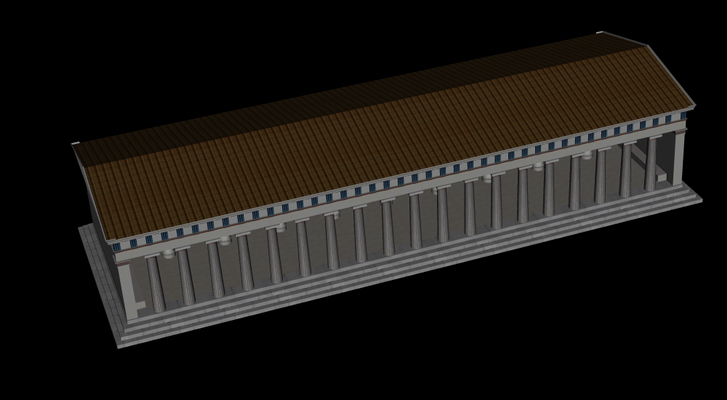|
|


The building discovered in 1981 is very fragmentary, while its identification has been controversial. It remains in its place from the Early Classical to the Late Roman periods, that is, throughout the three phases included in the representation (Classical, Hellenistic, Roman). The existing data do not allow the differentiation of building phases. There are differences of opinion as to its identification [Di Cesare, R., ‘Testimonianze per la Stoa di Peisianax come edificio (tardo-) arcaico dell’Agora di Atene’, Annuario della Scuola Archeologica di Atene 2 (2002), pp. 43-50], and this has affected the representation of the building with the putative presence of paintings depicting themes from Athens’ historical and mythological past.
We have accepted the hypothesis of the excavators [Shear, T.L., ‘The Athenian Agora: Excavations of 1980-1982’, Hesperia 53 (1984), pp. 5-19]. Only the dimensions of the building with the crepidoma are known. The digital reconstruction comprises a Doric colonnade in the façade and an internal Ionic colonnade, while the structure is defined by walls on its long sides [Μc Camp II, J., The Athenian Agora, A Short Guide to the Excavations, Excavations of the Athenian Agora, Picture Book no 16, American School of Classical Studies (Princeton 2003), pp. 43, fig. 66]. Findings incorporated in nearby Byzantine buildings have been used in the representation of its superstructure. Several parts of the columns, the capitals and the Doric frieze survive allowing us to calculate with a degree of accuracy its total dimensions. For the building’s long sides, the length to be digitally reconstructed depended on the number of columns posited for the interior: if these were 9, the total length of the building at its stylobate would have been 42.37m, while if these were 11, its length would amount to 50.36m. We adopted the first solution. The paintings are known from Pausanias’ descriptions and are represented according to Stansburry-O’Donnell’s study, ‘The Painting Program in the Stoa Poikile’, in Barringer, J.M. – Hurwitt, J.M. ( eds.), Periklean Athens and its Legacy. Problems and Perspectives (Austin 2005), pp. 73-87.

Poikile Stoa, 3D representation |
|

